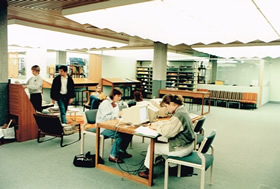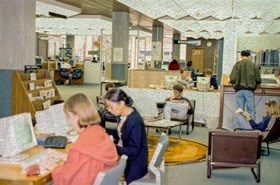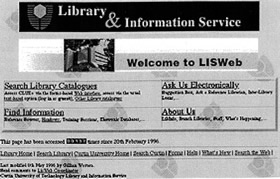
Library management systems
While work continued on improving the in-house automated systems developed in the previous decade, the Library moved towards implementing an integrated commercial library management system.
An online catalogue at last
In 1992, in a significant achievement, the Library introduced an online catalogue - the Curtin Library User Enquiries (CLUE) computer based service. Designed in-house, CLUE was the culmination of numerous online offerings developed over more than a decade, now brought together on the University’s mainframe computer. CLUE replaced KWOCA, LibInfo, LoansInfo and other separate systems.
CLUE was available on more than 50 terminals in Robertson Library and to anyone with access to the University’s computer network, whether at home or on campus. Clients found the online catalogue user-friendly and preferred it to the microfiche version. 12
This finally allowed the microfiche catalogue, as well as the last print catalogues - the 16mm film and video catalogue and the journals title catalogue – to be phased out.
Implementing a commercial library automation system
Even as the in-house product CLUE went live, the Library was investigating commercially available library systems and eventually decided on a software only solution with Data Research Associated (DRA). 13
The task of migrating to the DRA software was a Library priority for 1994. 14 The implementation phase took 37 weeks and was completed on time and on budget. The public face of the project, the newly branded CLUE+ catalogue, running on DRA software, went live in April 1995 15, providing clients with enhanced searching functionality.
University Librarian Vicki Williamson described the achievement as ‘breathtaking’ and believed that the new system once again placed the Library amongst a group of world-class automated libraries. 16
In 1996 full MARC (Machine Readable Catalogue) records for almost all of the Library’s journal holdings were purchased from the Australian Bibliographic Network 17 and imported into the database, improving the quality of the information the catalogue provided about journals.
A web interface for the catalogue was made available in 1996 and an updated version (DRAWeb2) was launched in 1999.
Premier Partnership Agreement with Ex Libris
Looking ahead to the future needs of information provision in the university environment, the Library signed a Premier Partnership Agreement with Ex Libris, a leading provider of library automation systems, in October 2001. Under this agreement, the Library moved to upgrade its systems to the full range of Ex Libris products, completing the process by the middle of 2002 and becoming the first partner worldwide to do so.
The installation of Ex Libris’ ALEPH 500 library system, MetaLib, SFX and DigiTool delivered benefits to Library clients through the single interface and broadcast searching capabilities of the MetaLib/SFX products. Importantly, it was a cost effective means for the University to position library services at Curtin with those at world-class institutions (such as Harvard and MIT) which used Ex Libris software.
Williamson believed that the Electronic Research Archive developed at the Library’s John Curtin Prime Ministerial Library was important in this regard – it became widely known and used and was a key factor in the Library becoming an Ex Libris partner. She saw the prime ministerial library as ‘the hook which captures people’s attention’ but behind which there was a ‘bigger, wider team of expertise and innovation and creativity’.18
Self-service loans
While the provision of electronic information to clients was a priority, the number of loans of print items (including audiovisual material) remained significant.
In 1993, the first client self service checkout terminal for books was installed near the loans desk of the Library. As clients made greater use of the service, additional terminals were installed as needed.
The number of loans was 484 000 in 1994, up from 367 000 in 1989. In 2001, the number of loans was around 20% lower at 404 500.
Library website
The Library established a web presence in May 1995 and the pages were given a major revamp in the first half of 1996 when a new Library and Information Service Web presence (LISWeb) was launched.
 Clients using the online catalogue, mid 1990s.
Clients using the online catalogue, mid 1990s.
CLUE allowed users to search the catalogue for books, journals, audiovisual and other resources, check availability and reserve or renew items, as well as view their personal information and find general information about the Library and its services.
 Level three of the Library in the mid 1990s, showing catalogue terminals, comfortable seating areas and the information desk.
Level three of the Library in the mid 1990s, showing catalogue terminals, comfortable seating areas and the information desk.
s.jpg) A self-service book checkout terminal in the Library (screenshot taken from the LibTrek Library tour developed in 1994).
A self-service book checkout terminal in the Library (screenshot taken from the LibTrek Library tour developed in 1994).
The self-service checkout terminals for loans provided faster service for clients in busy periods and significant savings in Library staff time.
 A screenshot of the Library's home page in 1996, (black and white image taken from Library Lines issue 2, 1996).
A screenshot of the Library's home page in 1996, (black and white image taken from Library Lines issue 2, 1996).
The new website was part of the University’s Electronic Campus Project. It provided four access points for users:
* Search Library catalogues
* Find information
* Ask us electronically
* About us
The Library website underwent continual revisions and expansion as more services were made available electronically and an information rich web presence became ever more important. The site was substantially updated in 1997 and again in 1999.